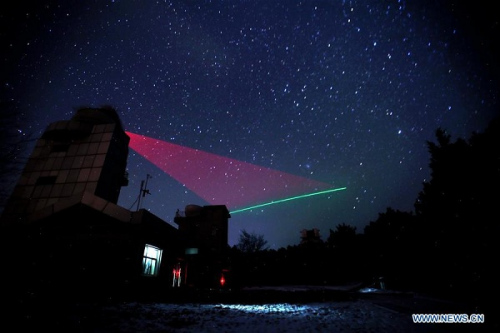
Photo taken on Nov. 26, 2016 shows a quantum communication ground station in Xinglong, north China's Hebei Province. (Xinhua/Jin Liwang)
The landmark breakthrough on intercontinental quantum-encrypted communications made by Chinese scientists opens the window for global quantum communications, turning the once-doubted quantum phenomena into reality, a world leading quantum physicist told Xinhua.
Renowned scientist Anton Zeilinger, seen as a pioneer in the field of quantum information and of the foundations of quantum mechanics, believes the landmark quantum-encrypted intercontinental video call between China and Austria is very important and impressive.
Quantum cryptography is the science of exploiting quantum mechanical properties to encrypt data. Quantum mechanics is a fundamental theory in physics which describes nature at the smallest scales of energy levels of atoms and subatomic particles.
"I see this as a part of the goal of building a future quantum internet, where in this case China enabled a worldwide quantum-secure communication," the physicist said.
Zeilinger has cooperated with Chinese physicists on quantum communications such as the Chinese "quantum experiments at space scale" (QESS) project.
On Sept. 29, a team of Chinese scientists in Beijing led by Bai Chunli, president of the Chinese Academy of Sciences, held a half-hour video call with Zeilinger, who happens to be the president of the Austrian Academy of Sciences, and his colleagues in Vienna, using quantum encryption developed from the quantum phenomena called quantum entanglement that secures the communications.
Zeilinger was particularly impressed by how smoothly the tests ran, and how good the quality of the connection was between satellites and the ground stations.
"What was really impressive was that the connection was of such high quality. I was really impressed by the fact that the data collection via the satellites worked, I would say, even better than we expected," said Zeilinger.
ONE UP ON EINSTEIN
For many quantum physicists, this practical application of the technology is undoubtedly an important milestone in the history of quantum mechanics, as the so-called mysterious quantum entanglement phenomena was made real.
The phenomena were the subject of a 1935 paper by Albert Einstein, Boris Podolsky, and Nathan Rosen. However, Einstein and others considered such behavior to be impossible, as it violated the local realist view of causality, and Einstein described it as "spooky action at a distance".
"Einstein himself would be really surprised," Zeilinger laughed, saying, "Because these concepts like entanglement now find practical application -- he would never have expected that."
He said the important point was that these quantum phenomena are no longer a matter of philosophical curiosity, but also an actual technology with real applications.
In practice, the first main application of the technology is secure communications, which Zeilinger believes could be used by banks, governments, and a select few smaller institutions within the next ten years, to safely exchange data and communications.
The stage is now set for the cutting-edge technology to be implemented worldwide.
With espionage and hacking of great concern, particularly when it comes to state secrets or important commercial information, the technology will be of high importance to such institutions.
Over the next 20 years, the University of Vienna professor expects the technology to spread worldwide, initially parallel to the current internet, and may later even take over as the "new quantum internet".
Quantum computers could also be employed together with the internet and satellites to form the basis of the new technology.
Zeilinger said China's success in conducting the QESS project and other cutting-edge scientific endeavors is in part due to an ability to make decisions on such projects more quickly than in Europe.
Its system sets a focus on technology, and makes sure people working on projects can reach their goals, and receive enough financial and institutional support. At present its research capacity also matches that of Europe and the United States, Zeilinger believes.
China invested a lot in quantum-related projects, and has successfully sent a quantum satellite Micius into space, while having several receiving stations domestically.


















































